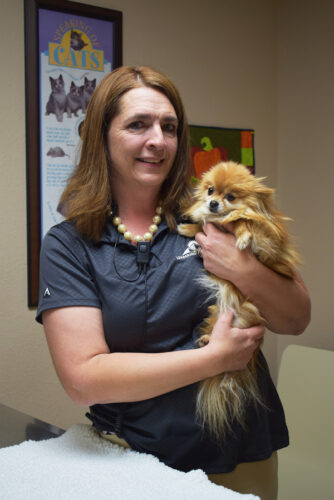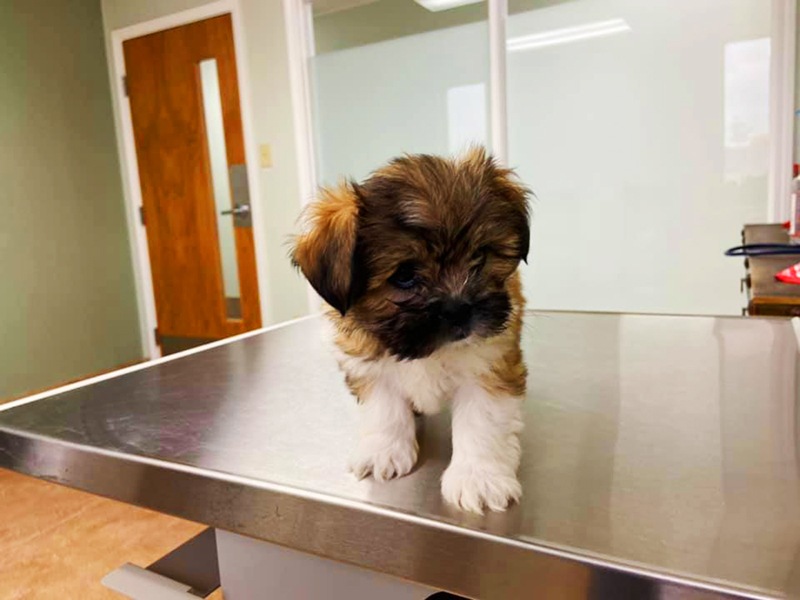BELEN — They might be sock stealers or even bed hoggers, but our pets are our best friends, our comforting companions and an integral part of our families.
Just like we take care of our human health, it should be no different for our pets, says local veterinarian Dr. Brenda Mack, DVM.
Diet, exercise and routine medical checkups are just some aspects of healthy living we need to maintain and monitor in our pets. Mack, who has been practicing veterinary medicine for 23 years — 21 at Valencia Animal Clinic in Belen — said a happy pet is a healthy pet.
Pet health and wellness should begin almost immediately once you welcome that new furry friend into your home.

Clara Garcia | News-Bulletin photo
Dr. Brenda Mack, DVM, at Valencia Animal Clinic in Belen, with her 2-year-old Pomeranian/Chihuahua named Caramel Macchiato.
“When you first get a puppy, you’ll want to have it in your home for a day or two and see what’s normal for them,” said Mack, who specializes in small animal general medicine. “Most puppies … eat, drink, they play, they pee and poop and they sleep. It’s just rinse and repeat. If any of those (activities) are out of whack, it would be something we need to see.”
The veterinarian said it’s important to get your animal in for a wellness appointment, where a doctor can check for any congenital defects as well as any teeth and pallet issues. Mack said with puppies, internal parasites including heartworm, roundworm, hookworms and Toxacara, can be a problem, especially in New Mexico. These parasites can cause malnutrition, diarrhea and vomiting.
“During the first visit, we’ll do a complete exam and start them on a series of vaccines,” Mack said. “Usually, we’re seeing the puppies at 6 to 8 weeks of age, and then we’re giving them the vaccines every three to four weeks until the puppy reaches 16 weeks of age.”
Mack says people are becoming educated about vaccines in the age of the coronavirus, and explained pet vaccinations are very important because parvo and distemper are prevalent in New Mexico.
“A lot of it is education, and if everyone is taking their dogs in to get the proper vaccinations, then all the dogs are vaccinated and you develop herd immunity,” she said. “But we’re still having a very large population that have the parvo virus, and a lot of dogs still die of the virus every year, which is preventable if people vaccinate their animals.”
After the first series of vaccinations are completed, Mack says another vaccine is given at the dog’s first birthday, and then every three years after that.
Along with regular checkups — annually for the first seven years, and twice a year thereafter — Mack says proper dental hygiene is also vital.
“A lot of times, smaller breed dogs develop dental disease at a faster rate. They also don’t adequately chew on anything that removes biofilm, which builds up and is cemented to the teeth.
“If they already have a smell component, then they already have dental disease,” she explained. “You can start brushing their teeth when they are puppies. It’s about getting them used to it. In dogs, it not so much brushing them, it’s about wiping them. Make a routine, but it has to start at an early age.”
The decision to spay or neuter your pet is one of the most important choices you make impacting their long-term health, Mack said.
“If you do not spay your dog, the chances of getting a pyometra, which is a life-threatening a uterine infection, goes up,” she said. “They could also develop mammary tumors.”
Neutering male pets eliminates their risk of testicular cancer and results in lower rates of prostate cancer.
Mack said getting your pets spayed or neutered can be done at 6 months of age. She explained waiting a little longer for large-breed dogs might be better, saying there may be some association with knee problems and certain cancers when dogs are spayed and neutered too young.
“I personally discuss all options with the client and individualize the service because if you wait until a Great Dane is a year old, it will be a much more expensive surgery, and you’ll have more complications,” Mack said.
Research shows the life expectancy of neutered male dogs is 13.8 percent longer, and that of spayed female dogs is 26.3 percent longer. The average age of death of intact dogs is 7.9 years versus a significantly older 9.4 years for altered dogs.
You are what you eat isn’t just a mantra for people. It goes for pooches, too. A high-quality diet is key to helping your dog live longer and healthier, Mack said.
Mack doesn’t recommend grain-free food, saying it may be dangerous for your dog’s health. The FDA is currently investigating many grain-free diets, which has a link to heart disease.
“With dog food, you generally get what you pay for to a certain extent,” she said. “You want to stay away from the less expensive dog food, and you’ll want to stay away from feeding your dogs people food.
“The dog’s GI tract is not the same as human’s, so anything that is fatty can cause life-threatening pancreatitis. They can’t digest fat as well as we can.”
If you’re set on giving your furry friend “people food,” Mack suggests raw vegetables, such as carrots and broccoli.

Clara Garcia | News-Bulletin photo
Vaccines help prevent many illnesses that affect pets. Vaccinating your pet has long been considered one of the easiest ways to help him live a long, healthy life, says Dr. Brenda Mack, DVM, with Valencia Animal Clinic.
The veterinarian says obesity can also cause serious health problems for your pet.
“If you have your dog at the correct body weight, on average, they live two years longer,” she said. “They’ll have a lot of less health problems and vet expenses. One of the most important things we do during our regular visits is nutrition counseling.
“Most people don’t realize their dogs are overweight,” she said. “People are killing them with kindness, and a lot of times we show them how much we love them by feeding them too much.”
Regular exercise is essential to stay healthy and fit, and dogs are no exception to this, Mack says. Exercise is just one of your dog’s basic needs.
No two dogs are the same, and your dog may need more exercise than others depending on breed and age.
“Some sort of exercise — 15 minutes — at least four times a week,” Mach suggests. “It needs to be sustained exercise, activity for a minimum of 15 minutes.”
Walking is the classic form of exercise we tend to give our dogs, but playing fetch and hiking are great forms of exercise as well.
Cat Health
• Make carriers comfy and part of their environment: Leave carriers open and in your living space. Blankets and toys can be placed in the carrier to entice your cat to want to spend time in it, using it as a resting space.
• Offer a variety of foods to your cat: Offer different textures and flavors of food to your cat. This can help your veterinarian in the future if diet is changed. Sometimes as a cat gets older, prescription diets may be needed, and this will aid in food transition. Offer dry kibble, soft foods, different flavors and pill pockets.
• Encourage hunting of food: Hide food bowls throughout your house. This will encourage hunting skills in your cat. By moving food around every few months, this keeps their mind alert and activity level up.
• Create an acceptance of car rides: Take your pet on regular car rides. This will decrease anxiety that is caused by riding in a car. Even if you are not going to the vet, take a ride around the block. Your pet will become accustomed to being in the carrier and riding in a car. • Annual visits are important: It is important for your pet to see your veterinarian annual. Preventative visits will help keep your pet healthy.
As your pet becomes older, they will need different care, Mack says.
When a dog is considered a senior largely depends on breed. Smaller dogs don’t reach their golden years until they’re about 10 or 12, while a Great Dane may attain senior status at a younger age. Beyond size and breed, genetics, diet and environment all have an impact on a dog’s life expectancy.
Mack says dental hygiene is crucial as your dog ages, so regular brushing or wiping can prevent dental disease. Older dogs often have food issues, as well, including problems with chewing, a lack of appetite and obesity. Dietary changes may including adding more fiber in their meals.
Much like people, aging dogs experience pain and have difficulty in physical activity; however, Mack says, it’s still vital to a dog’s overall health.
“Take your older dog on shorter walks,
and continue playing with them as much as possible,” Mack said.
As a dog gets older, they will probably need to see a vet more often. There are a lot of ways to keep your pooch happy and healthy, but developing a relationship with your veterinarian is also very important, Mack said.
Geriatric pets should have semi-annual veterinary visits instead of annual visits so signs of illness or other problems can be detected early and treated. Senior pet exams are similar to those for younger pets, but are more in-depth, and may include dental care, possible bloodwork and specific checks for physical signs of diseases that are more likely in older pets.
“Don’t wait until it’s an emergency to get to know your vet,” she said. “They should know your name, they should know your pet by name. You need to have a valid relationship with them.”
Many breeds have predispositions toward certain conditions and diseases, including arthritis, hip dysplasia, cancer and diabetes.
Mack says a pet can bring joy to almost every family, and although being a pet owner can be fun, it’s also a huge responsibility. From proper nutrition and regular exercise to preventative care and training, a happy and healthy pet is something you’ll be able to enjoy for years.
Clara Garcia is the editor and publisher of the Valencia County News-Bulletin.
She is a native of the city of Belen, beginning her journalism career at the News-Bulletin in 1998 as the crime and courts reporter. During her time at the paper, Clara has won numerous awards for her writing, photography and typography and design both from the National Newspaper Association and the New Mexico Press Association.




